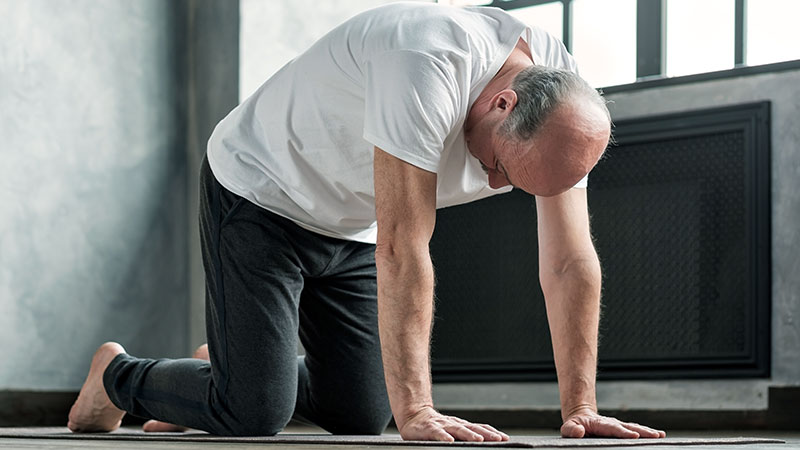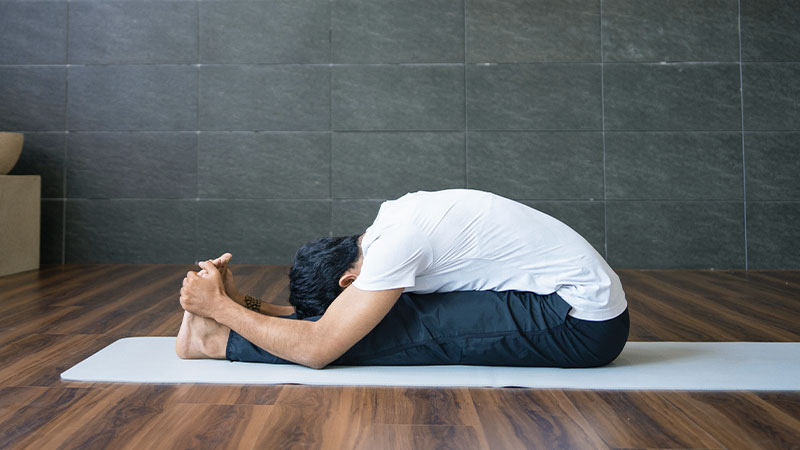Beginner yoga poses for seniors offer a gentle yet effective way to enhance physical health and mental well-being.
As seniors embark on their yoga journey, it’s crucial to prioritize safety and accessibility while reaping the benefits of this ancient practice.
Yoga provides seniors with an opportunity to improve flexibility, strength, and balance, fostering greater mobility and independence in daily life.
With mindful guidance and tailored modifications, seniors can comfortably explore foundational yoga poses that promote relaxation, stress reduction, and improved overall health.
Here, we will deal with a selection of beginner-friendly yoga poses specifically curated to meet the needs of seniors, empowering them to embark on a fulfilling yoga practice that supports their unique journey toward enhanced vitality and vitality.
Let’s dive into the world of yoga and unlock its transformative potential for seniors. Stay focused.
Why Yoga for Seniors?
Yoga for seniors offers a myriad of physical and mental health benefits tailored to their unique needs. As individuals age, they often experience decreased flexibility, strength, and balance, leading to a higher risk of falls and injury.
Yoga’s gentle, low-impact movements help improve flexibility, strength, and balance, reducing the likelihood of falls and enhancing overall mobility.
Moreover, yoga promotes relaxation and stress reduction through breathing techniques and mindfulness practices, which can alleviate symptoms of anxiety, depression, and insomnia commonly experienced by seniors.
Additionally, yoga can improve cognitive function and memory, supporting brain health in older adults.
Furthermore, participating in yoga classes fosters social connection and a sense of community, combating loneliness and isolation often prevalent among seniors.
Integrating yoga into their routine can significantly enhance seniors’ quality of life by promoting physical wellness, mental clarity, and social engagement.
Getting Started: Preparing for Yoga Practice
As seniors venture into yoga, it’s crucial to approach the practice with mindfulness and attentiveness to their unique physical needs and limitations.
Preparing for yoga practice involves both physical and mental readiness, ensuring a safe and fulfilling experience.
Consultation with Healthcare Provider
Before beginning any new exercise regimen, including yoga, seniors should consult their healthcare provider, especially if they have pre-existing health conditions or concerns.
A healthcare provider can offer personalized guidance based on individual health status and recommend modifications to ensure safety during yoga practice.
Selecting Appropriate Yoga Props

Seniors may benefit from using yoga props such as blocks, straps, and bolsters to support their practice and accommodate limited mobility or flexibility.
These props provide stability and assistance in achieving proper alignment in yoga poses, reducing the risk of strain or injury.
Choosing Suitable Yoga Classes
Seniors should opt for yoga classes specifically designed for their age group or those labeled as gentle, restorative, or chair yoga.
These classes typically incorporate modifications and adaptations tailored to seniors’ needs, emphasizing gentle movements, mindful breathing, and relaxation techniques.
Creating a Comfortable Practice Space
Setting up a conducive environment for yoga practice is essential for seniors. Designate a quiet, clutter-free space with ample room to move comfortably.
Ensure the flooring is non-slip and supportive, and consider using additional padding or a yoga mat for cushioning and stability.
Establishing Realistic Expectations
Seniors should approach yoga practice with patience and an open mind, understanding that progress may be gradual and individualized.
Setting realistic expectations and honoring the body’s limitations while embracing the journey of self-discovery and self-care is key to a fulfilling yoga practice as a senior.
By following these preparatory steps, seniors can embark on their yoga journey with confidence, setting the stage for a rewarding and transformative experience that nurtures physical, mental, and emotional well-being.
10 Best Beginner Yoga Poses for Seniors
A yoga journey can be an enriching experience for individuals of all ages, including seniors.
However, it’s essential to prepare adequately before diving into practice to ensure safety and maximize the benefits. Check out the following 10 beginner yoga poses for seniors.
1. Mountain Pose (Tadasana)

Type: Standing Pose
In Tadasana, you stand tall with feet hip-width apart, grounding firmly through the feet, lengthening the spine, and reaching the crown of the head toward the sky. Arms are relaxed by the sides with palms facing forward.
Benefits: Tadasana improves posture and alignment, strengthens the legs, ankles, and core muscles, and promotes body awareness. It also helps in reducing flat feet and alleviating sciatica pain by improving spinal alignment.
2. Chair Pose (Utkatasana)

Type: Standing Pose
Utkatasana involves bending the knees and lowering the hips as if sitting into an imaginary chair, with arms raised overhead or held in front of the chest.
Benefits: This pose strengthens the quadriceps, glutes, and core muscles, improves balance and stability, and enhances mobility in the ankles and knees. Chair Pose also stimulates the heart and circulation, promoting cardiovascular health.
3. Tree Pose (Vrksasana)

Type: Balance Pose
Vrksasana involves standing on one leg with the other foot placed on the inner thigh or calf of the standing leg, hands pressed together at the heart center or raised overhead.
Benefits: Tree Pose enhances balance, concentration, and focus, strengthens the muscles of the standing leg, and improves posture. It also stretches the hips, inner thighs, and shoulders, fostering flexibility and mobility.
4. Cat-Cow Stretch

Type: Dynamic Stretch
Cat-Cow Stretch is a gentle flowing sequence that involves moving between Cat Pose (rounding the back and tucking the chin) and Cow Pose (arching the back and lifting the head and tailbone).
Benefits: This sequence improves spinal flexibility and mobility, releases tension in the back, neck, and shoulders, and massages the internal organs, aiding in digestion and promoting spinal health. Cat-Cow Stretch also enhances breath awareness and relaxation.
5. Forward Fold (Uttanasana)

Type: Forward Bend Pose
Uttanasana involves folding forward from the hips, letting the upper body hang over the legs. The knees can be slightly bent if needed, and the hands can reach for the floor, shins, or hold onto opposite elbows.
Benefits: Forward Fold stretches the hamstrings, calves, and lower back, relieving tension and stiffness in these areas.
It also calms the mind, soothes the nervous system, and promotes relaxation. Uttanasana can help alleviate symptoms of stress, anxiety, and mild depression.
6. Warrior I (Virabhadrasana I)

Type: Standing Pose
Virabhadrasana I involves stepping one foot back into a lunge position while keeping the front knee bent at a 90-degree angle, with the back leg straight and the foot turned out slightly. The arms are raised overhead, palms facing each other.
Benefits: Warrior I strengthens the legs, glutes, and core muscles, improves balance and stability and opens the chest and shoulders. It also cultivates inner strength, confidence, and determination, fostering a sense of empowerment and resilience.
7. Warrior II (Virabhadrasana II)

Type: Standing Pose
Virabhadrasana II begins in a similar stance to Warrior I, but the hips and shoulders are opened to the side, with the arms extended parallel to the floor, and palms facing down. The gaze is directed over the front fingertips.
Benefits: Warrior II strengthens the legs, hips, and shoulders, improves stamina and endurance, and increases flexibility in the hips and groin.
It also enhances focus and concentration, cultivating a sense of groundedness and presence in the moment. Warrior II can help improve posture and alignment, relieving tension in the upper body.
8. Downward-Facing Dog (Adho Mukha Svanasana)

Type: Inversion Pose
Adho Mukha Svanasana involves forming an inverted V-shape with the body, pressing the hands and feet firmly into the ground while lifting the hips toward the ceiling.
The heels are ideally grounded, and the head is relaxed between the arms, forming a straight line from wrists to hips.
Benefits: This pose stretches and lengthens the spine, hamstrings, calves, and shoulders, promoting flexibility and mobility.
Downward-Facing Dog also strengthens the arms, shoulders, and core muscles, improves circulation, and relieves tension in the upper body.
It can help alleviate symptoms of mild anxiety and depression by calming the mind and reducing stress.
9. Child’s Pose (Balasana)

Type: Resting Pose
Balasana involves kneeling on the floor, sitting back on the heels, and then folding the torso forward, resting the forehead on the ground or on a prop. The arms can be extended overhead or alongside the body, palms facing up.
Benefits: Child’s Pose gently stretches the hips, thighs, and ankles, releasing tension and promoting relaxation in these areas. It also elongates the spine and helps alleviate lower back pain.
Balasana calms the mind, soothes the nervous system, and fosters a sense of surrender and introspection. It is often used as a resting pose during yoga practice to regroup and reconnect with the breath.
10. Bridge Pose (Setu Bandhasana)

Type: Backbend Pose
Setu Bandhasana involves lying on the back with knees bent and feet hip-width apart, arms alongside the body with palms facing down.
On an inhalation, lift the hips toward the ceiling, pressing into the feet and engaging the glutes and core muscles. The shoulders remain grounded, and the chin is slightly tucked toward the chest.
Benefits: Bridge Pose strengthens the back, glutes, and hamstrings, improves spinal flexibility, and opens the chest and shoulders. It also stimulates the thyroid gland, boosting metabolism and energy levels.
Setu Bandhasana can help relieve symptoms of stress, fatigue, and mild depression by promoting feelings of vitality and well-being.
Safety Tips and Precautions: Yoga for Seniors
Yoga offers a plethora of physical and mental health benefits for seniors, promoting flexibility, strength, balance, and relaxation.
However, it’s essential for seniors to practice yoga safely, considering their unique physical limitations and health concerns.
By adhering to safety tips and precautions, seniors can enjoy the rewards of yoga while minimizing the risk of injury. Here are some key guidelines to keep in mind:
Consultation with Healthcare Provider
Before starting a yoga practice, seniors should consult with their healthcare provider, especially if they have any pre-existing health conditions or mobility issues.
A healthcare professional can offer personalized advice and recommend modifications to ensure safe participation in yoga.
Listen to Your Body
Seniors should listen to their bodies and practice within their limits. It’s crucial to avoid pushing too hard or attempting poses that cause pain or discomfort.
Instead, focus on gentle movements and gradual progression, honoring the body’s signals and respecting its boundaries.
Use Props and Modifications
Yoga props such as blocks, straps, and bolsters can provide support and assistance in achieving proper alignment in poses.
Seniors should not hesitate to use props and explore modifications to adapt poses to their individual needs and abilities, ensuring a safe and comfortable practice.
Mindful Breathing
Incorporating mindful breathing techniques into yoga practice can enhance relaxation, reduce stress, and promote awareness of the present moment.
Seniors should focus on deep, diaphragmatic breathing and avoid holding their breath during poses, which can increase tension and strain on the body.
Stay Hydrated and Energized
Seniors should stay hydrated before, during, and after yoga practice, especially if practicing in a heated environment.
It’s essential to drink water regularly and replenish electrolytes to prevent dehydration and maintain energy levels. Additionally, seniors should fuel their bodies with nutritious foods to support overall health and well-being.
By following these safety tips and precautions, seniors can enjoy the numerous benefits of yoga while prioritizing their health and safety.
With mindful practice and attention to individual needs, yoga can be a valuable tool for promoting physical vitality, mental clarity, and emotional well-being in seniors.
Wrapping Up
Incorporating yoga into their routine can be immensely beneficial for seniors, fostering physical wellness, mental clarity, and emotional balance.
By starting with beginner-friendly poses and practicing with mindfulness and caution, seniors can experience improved flexibility, strength, and overall quality of life.
With guidance from healthcare professionals and a commitment to listening to their bodies, seniors can embark on a yoga journey that supports their individual needs and enhances their well-being. Thank you very much.
I am a fitness instructor and I have been in the industry for 9 years. I have a passion for health and fitness.
I am a fitness instructor with over 9 years of experience in the industry. My passion is health and fitness and I would love to share my knowledge with you!